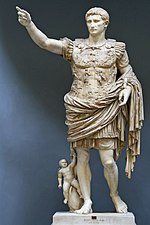Apollo Belvedere

The Apollo Belvedere (also called the Belvedere Apollo, Apollo of the Belvedere, or Pythian Apollo) is a celebrated marble sculpture from classical antiquity. The Apollo is now thought to be an original Roman creation of Hadrianic date (c. 120–140 AD), though in a Hellenistic style. The distinctively Roman footwear is one reason scholars believe it is not a copy of an original Greek statue. It was rediscovered in central Italy in the late 15th century during the Italian Renaissance and was placed on semi-public display in the Vatican Palace in 1511, where it remains. It is now in the Cortile del Belvedere of the Pio-Clementine Museum of the Vatican Museums complex. From the mid-18th century it was considered the greatest ancient sculpture by ardent neoclassicists, and for centuries it epitomized the ideals of aesthetic perfection for Europeans and westernized parts of the world.
Excerpt from the Wikipedia article Apollo Belvedere (License: CC BY-SA 3.0, Authors, Images).Apollo Belvedere
Rampa dell'Archeologia,
Geographical coordinates (GPS) Address Nearby Places Show on map
Geographical coordinates (GPS)
| Latitude | Longitude |
|---|---|
| N 41.906389 ° | E 12.454444 ° |
Address
Musei Vaticani
Rampa dell'Archeologia
00120 , Vatican City
Vatican City
Open on Google Maps










